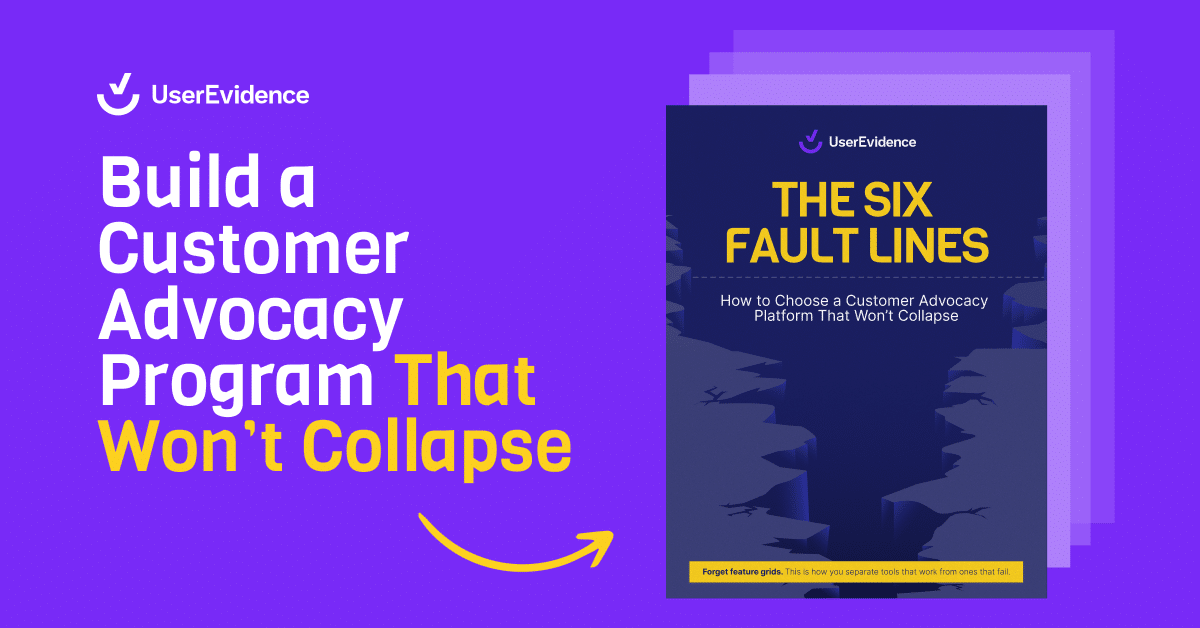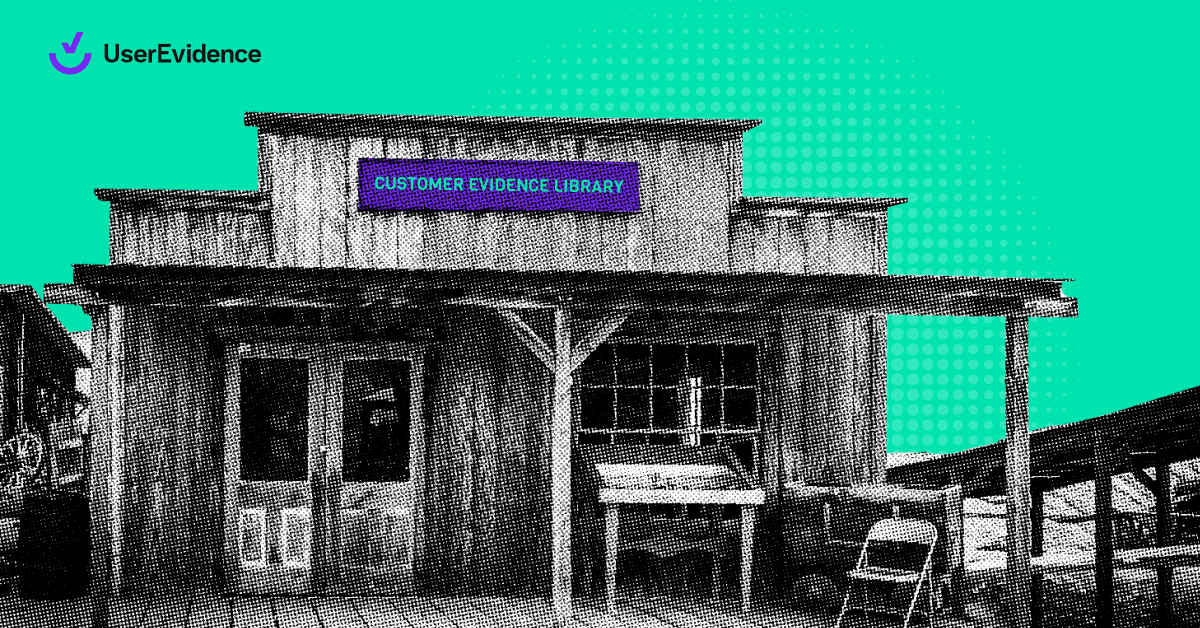TL;DR
Traditional case studies aren’t dead, but the most effective B2B brands are completely reimagining what they can be. The best companies are moving beyond the one-customer-one-story model to create tactical playbooks that give away specific “how-to” steps, leveraging multiple customer voices to build statistical significance, and distributing customer evidence throughout their marketing—not just in dedicated PDFs. Sequel.io, Mutiny, Clay, Sourcescrub, and Expel are leading the way with innovative approaches that convert prospects into buyers by focusing on specific use cases rather than generic success stories.
**More of a watcher than a reader? This blog was written using the main takeaways from our recent webinar “How To Build A Winning Case Study That Converts Prospects Into Customers”, which you can watch on-demand here.**
Let’s be real. When was the last time you read a case study from start to finish?
If you’re like most people, your eyes glaze over at yet another Problem/Solution/Impact story with the same generic structure and bland copy that’s been done to death since the dawn of B2B marketing.
But here’s the thing—case studies aren’t going away. The marketers who are absolutely crushing it right now aren’t abandoning case studies. They’re completely reimagining what customer evidence can be, and the results are game-changing for their conversion rates.
The new way to think about case studies
Our Evidence Gap Report revealed some pretty eye-opening stats: 67% of buyers said the most important factor when evaluating new software is a compelling and statistically significant business case around potential ROI. Close behind at 61% was proof of vendor success with similar customers.
Yet most marketing teams are stuck in an endless treadmill of producing ~3 case studies per quarter that collect dust in a blog corner while sales uses one outdated favorite with the biggest logo, even when it’s completely irrelevant to the prospect.
Sound familiar?
Here’s the thing: It’s not the Problem/Solution/Impact format itself that’s broken. The format works as a story. It’s how we’ve been executing it that’s the problem. Most case studies today lack specificity, emotional resonance, and authentic customer struggles. We marketers (who never ruin anything, right?) have been “phoning it in” with generic content that doesn’t truly connect.
The best marketers are transforming the traditional formula into:
- Problem: Day-in-the-life stories connecting to broader trends (get really specific, and put your storytelling hat on)
- Solution: A tactical playbook others can follow with specific steps (give away the secret sauce)
- Impact: Wins beyond the immediate team with cross-functional feedback and verified stats (not just “revenue increased by 400%”–no one’s buying those inflated stats anymore)
But there’s an even bigger reframe happening. The most innovative companies are questioning the very definition of what a case study is. They’re:
- Reconsidering interviews as the only info capture method (surveys can be way more efficient)
- Extracting smaller proof points from customer interactions
- Thinking “1 use case = 1 case study” rather than “1 customer = 1 case study”
It’s not just about telling a story—it’s about giving away the playbook that others can follow. The future of case studies won’t be long-form PDFs as the main format for customer storytelling, and they won’t always follow the “1 customer = 1 story” model.
Case studies 🤝 customer evidence libraries
This evolution is part of a larger shift toward building comprehensive customer evidence libraries. The truth is, your customer evidence should be everywhere, not just in dedicated case studies. Your customers should tell your story throughout your website, in blog posts, on sales calls, and beyond.
The companies winning at this are creating versatile, bite-sized customer proof points that can be deployed wherever they’re needed. Now let’s look at five brands that are absolutely crushing this new approach.
5 brands nailing the new approach to case studies
1. Sequel.io’s Playbooks + Masterclass Combo
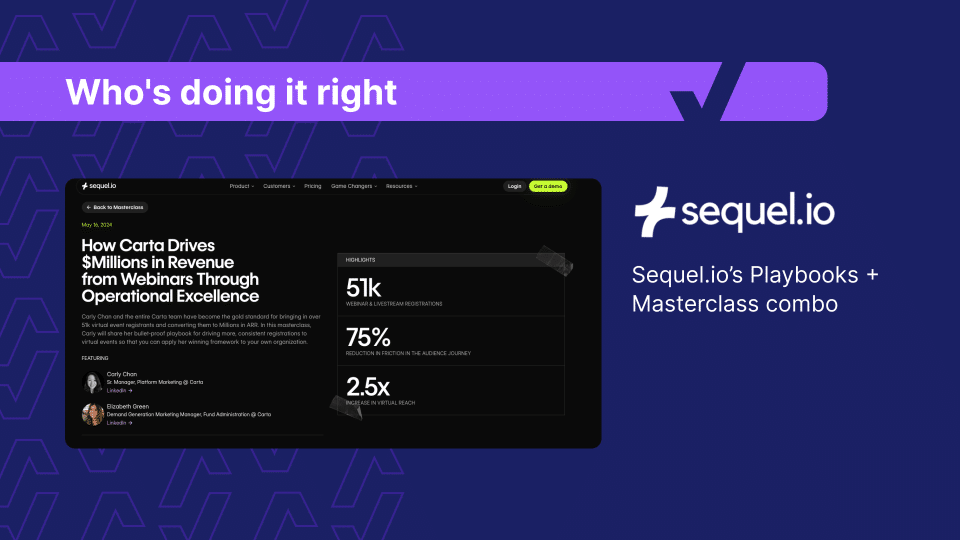
Sequel.io has transformed their case studies into a masterclass + playbook combo that delivers real value.
Their main customer stories feature the stats about what’s actually happening, but they don’t stop there. Their content is done in a very specific “here’s what they did” operational way. Scroll down and you’ll find both written content and live events diving into these use cases with the overarching stats and specifically what you can take from it.
For example, their case study on how Carta drives millions in revenue from webinars showcases impressive metrics (51k webinar registrations, 75% reduction in friction) while breaking down the exact operational excellence that achieved these results.
This approach transforms case studies from passive success stories into active resources that prospects can use to improve their own operations—building trust and positioning Sequel.io as a partner in their success.
2. Mutiny’s “What You’ll Learn” Framework
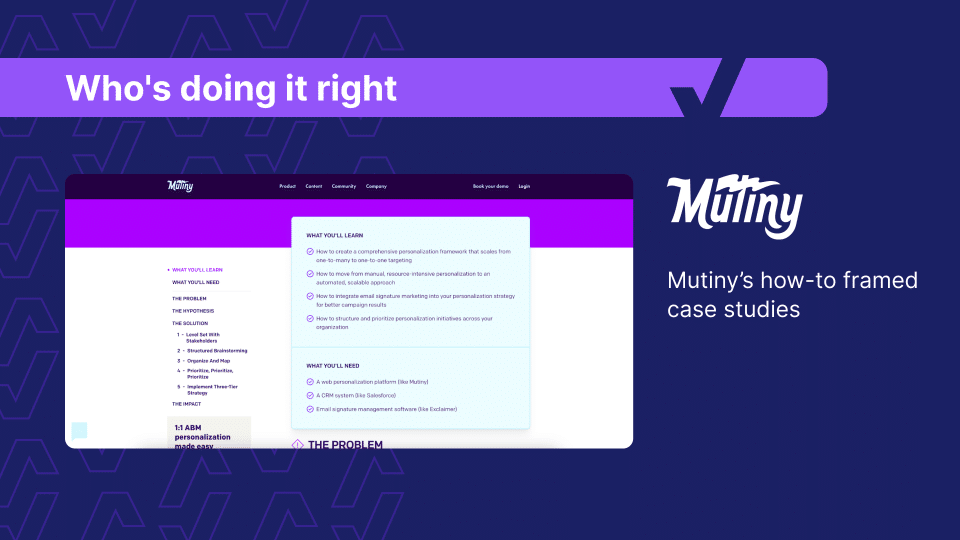
Mutiny was one of the first companies I noticed really pushing case studies forward in a tangible way. Their brilliant innovation? Starting each case study by explicitly telling you what you’ll get out of reading it.
I mean, duh, right? But how many companies actually do this?
Their case studies start with “What You’ll Learn” followed by “What You’ll Need” beyond just their product to achieve similar results. This immediately addresses the reader’s primary concern: “What’s in it for me?”
Their customer stories are all structured as playbooks or “how-to” guides framed around solving specific use cases or parts of the funnel. Their solution sections present step-by-step processes that readers can actually follow.
If they just infused a bit more customer evidence into these playbooks, I think it would take them another notch up. It’s already good, but that would make it even better.
3. Clay’s Tactical “Claybooks”
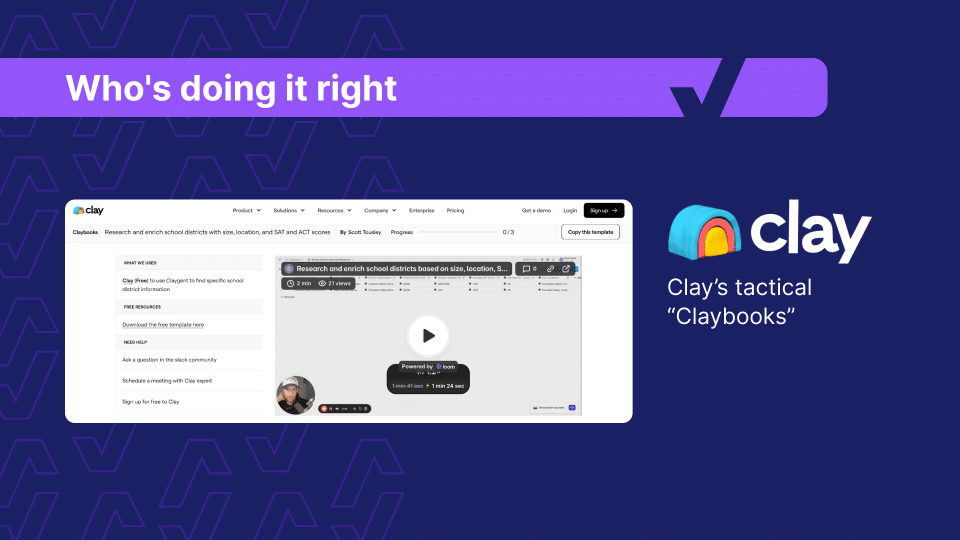
Clay is doing an incredible job with their GTM approach, especially their “Claybooks.” These are essentially playbooks for specific use cases, and they have tons of them because their product has such broad applications.
What makes Clay’s approach special is how detailed and tactical they get. Each Claybook provides a complete framework for accomplishing a specific task, showing exactly how their product fits into the process.
They’ve also revolutionized the traditional logo farm on their website (one of my favorite things I want to steal ASAP). When you hover over a company logo, you immediately see a testimonial. Click it, and you’re taken directly to the corresponding case study. So good!
The only thing that could improve their approach would be including even more customer examples and testimonials to further validate each methodology. If they just infused a bit of customer evidence in this, I think it takes it another notch up.
4. Sourcescrub’s Competitive Evidence
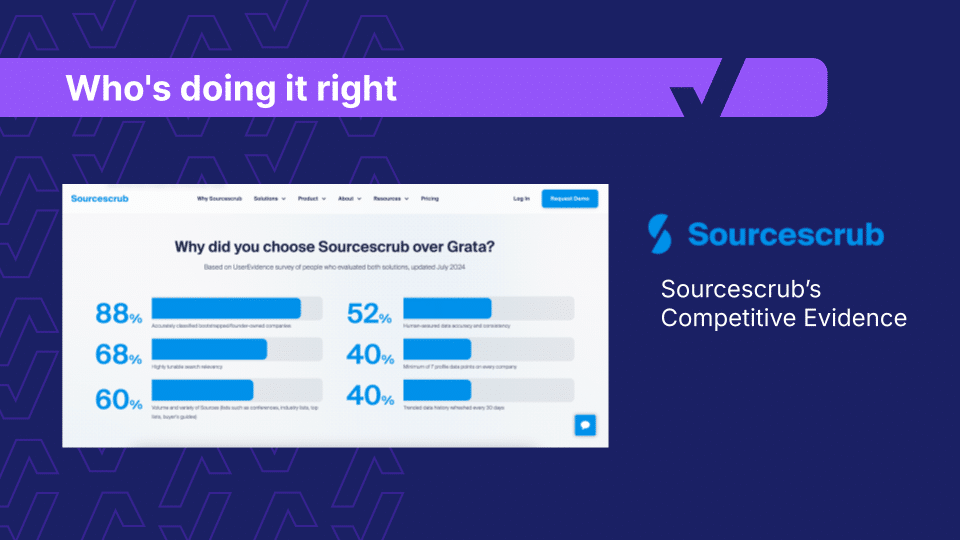
Sourcescrub is taking a bold approach by using verified customer feedback to strengthen their competitive positioning. Their competitive landing page doesn’t pull punches—it’s titled “Why did you choose Sourcescrub over Grata?” and delivers specific data points from actual customers.
What makes this approach powerful is that it’s backed by third-party verification. Through UserEvidence surveys, Sourcescrub has collected specific data points about why customers chose them over alternatives, with impressive stats: 88% prefer Sourcescrub’s accuracy in classifying bootstrapped/founder-owned companies, 68% cite highly tunable search relevancy, and so on.
This isn’t a traditional case study at all, but it’s customer evidence being used in a highly effective way. And because the data comes from multiple customers rather than just one or two anecdotes, it carries much more weight with prospects.
Even though people might not want to “trash talk” competitors publicly (I get it, I’m from the Midwest), anonymous verified feedback allows Sourcescrub to present compelling comparative data without putting any individual customer in an uncomfortable position.
5. Expel’s Enterprise-Focused Aggregated Evidence
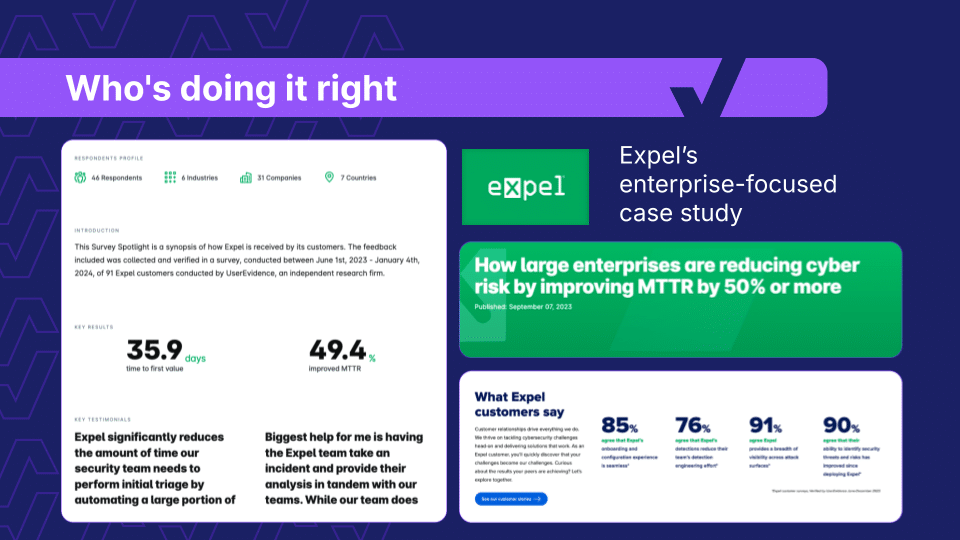
Expel has taken a statistical approach to customer evidence that perfectly addresses the needs of their enterprise audience. Rather than relying on a single customer story, they surveyed 46 respondents across 31 companies in 7 countries to create a comprehensive picture of how large enterprises are reducing cyber risk.
Their content focuses on a specific, high-value outcome—improving Mean Time to Remediate (MTTR) by 50% or more. By aggregating data from multiple sources, they’ve created a statistically significant business case that carries far more weight than a single customer anecdote.
The content includes specific data points (like 35.9 days to first value and 49.4% improved MTTR) alongside testimonials that speak to particular pain points. This mixture of quantitative and qualitative evidence creates a compelling narrative that resonates with enterprise prospects.
This approach is particularly effective in cybersecurity, where customers are often reluctant to share specifics about their security implementations. By aggregating anonymous data, Expel overcomes this hurdle while still providing valuable proof points.
The future of case studies
These innovative approaches represent where customer evidence is heading. Case studies are here to stay, BUT, a few reminders:
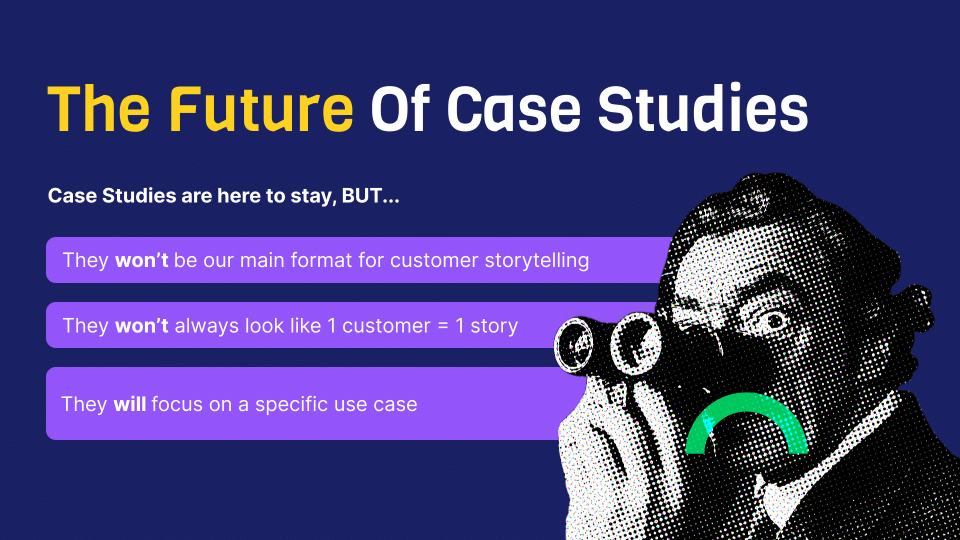
The most successful companies are:
- Focusing on specific use cases rather than general company stories
- Providing tactical playbooks that deliver real value to readers
- Aggregating data from multiple customers for greater credibility
- Distributing customer evidence across all marketing and sales channels
- Thinking beyond the traditional case study format
While the long-form case study isn’t disappearing completely, it’s evolving into something much more valuable—both for the companies creating them and the prospects consuming them.
By rethinking your approach to customer evidence along these lines, you can transform case studies from marketing checkbox items into powerful conversion tools that actually drive business results.
PS – UserEvidence can help you gather more customer evidence so you can infuse it in every case study, competitive landing page, and playbook you’ve got. Explore our Interactive Demo Center to see how, or book a demo with our team today.

